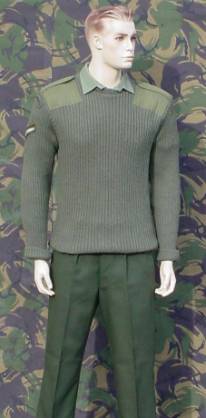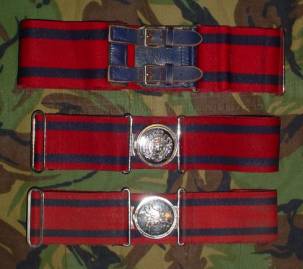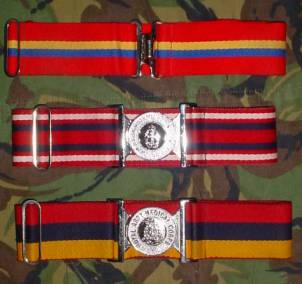No13 DRESS BARRACK TEMPERATE 1970-1991
No.13: Temperate barrack dress consists of: Bottle green trousers "Trousers, Man's, Army (Barrack Dress)", the khaki
shirt from No.2 dress, or "shirt KF/GS", with pullover "Jersey, Wool, Heavy" and stable belt.
No13 Dress, Enlisted, Royal Engineers

Some Regiments' Officers and WOs may wear coloured pullovers in place of the green pattern, The following regimental
patterns and colours are authorised:
| Grey/blue v-neck: | Royal Scots Dragoon Guards |
| Grey/blue/green knit: | Queen's Royal Lancers |
| Grey/brown v-neck: | 1st The Queen's Dragoon Guards |
| Grey/green v-neck: | Royal Regiment of Fusiliers |
| Green v-neck: | Princess of Wales's Royal Regiment |
| Lincoln green v-neck: | 68 Signal Squadron (V) |
| Pale green v-neck: | Royal Dragoon Guards |
| Dark green: | Queen's Royal Hussars |
| Emerald green v-neck: | Royal Army Dental Corps |
| Brunswick green v-neck: | 9th/12th Royal Lancers |
| Lovat green v-neck: | Royal Yeomanry |
| Green fleck v-neck: | Royal Wessex Yeomanry |
| Lovat green and red fleck v-neck: | 70 Signal Squadron (V) |
| Black: | Royal Tank Regiment |
| Black: | Royal Army Chaplains Department |
| Black: | Army Legal Services Branch |
| Black: | 265 Support Squadron (V) |
| Maroon: | Royal Army Veterinary Corps |
| Dull cherry v-neck: | Royal Army Medical Corps |
| Buff: | Mercian Regiment |
RAMC ENLISTED No13 DRESS

RAMC OFFICER No13 DRESS

No13 Dress encompases a wide range of uniforms, often dependent on individual unit requirements. In some Regiments and Corps, such as the Parachute Regiment, the Royal Engineers, Royal Electrical & Mechanical Engineers and Royal Signals, No13 Dress includes olive green "Trousers Lightweight" which are worn with "Shirt KF/GS", "Jersey, Wool, Heavy", Puttees and Boots DMS, often referred to as "Working Dress", which crosses over into No12 Dress.
WORKING DRESS - ROYAL ENGINEERS

No14 Dress (Shirt-sleeve version of No13 Dress) Officer, Royal Engineers

Originally, stable belts were worn by cavalrymen in the working dress they used for cleaning the stables and tending
to their horses, but in the 1950s they spread to all branches of the armed forces, adding unit identity to the drab khaki
working uniforms.
ROYAL ENGINEERS STABLE BELTS
TOP TO BOTTOM: 1st PATTERN, 2nd PATTERN & 2nd PATTERN AIRBORNE

Initially they were resisted by many senior officers, who saw them as too individualistic, but they soon became accepted throughout the forces.
STABLE BELTS
TOP TO BOTTOM:RMA SANDHURST, 2nd PATTERN QARANC & RAMC

A stable belt is a wide webbing belt, usually a single solid colour or horizontally striped in two or more different colours.
It is worn around the waist in No13 Dress and worn through the trouser belt loops in No14 Dress (shirt-sleeve order).
The original cavalry stable belts buckled at the side to avoid chafing the soldier's stomach as he bent down during
stable work, but many stable belts are now clipped at the front, sometimes behind a metal belt plate (usually bearing
the badge of the regiment), although a few regiments such as the Light Infantry clip their stable belts at the front with
the original two leather straps. A large number of units, however, continue to use the traditional method of securing
the belt using two leather straps and metal buckles at the left-hand side.
Today, every regiment and corps of the British Army has its own stable belt, often very colourful. Stable belts are worn by
soldiers who have completed "Phase 2" training, and are purchased by individual service personnel, not issued,
so are theoretically neither regulation nor compulsory but since most people own one they are effectively uniform
items in the Army